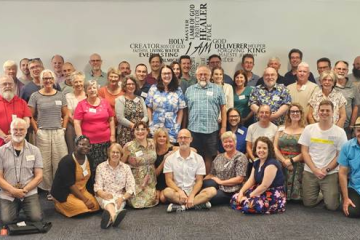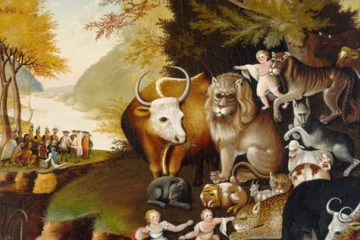In the last few decades there has been a rise in Christian celebrations of the Jewish Passover or Seder in order to better understand what Jesus has done for us. We held a Passover meal here last year – the Soup and Faith group led it – and it was wonderful! (Do not miss the Tenebrae service they are also leading here on Thursday night at 7:30pm!)
There are some Jews (and some Christians) that say that this meal which commemorates the freeing of the Israelites from slavery in Egypt is so Jewish that it doesn’t belong in a Christian setting. Others, however, say Seder traditions are always evolving, and as long as Christian celebrations are faithful to the intention and history of the ritual, they are not offensive.
What everyone agrees on is that the Seder Jesus would have celebrated is not the same as the Seder that is celebrated today. Eating gifilta fish (poached deboned fish) or hard-boiled eggs or hiding a piece of the matzah (unleavened bread) during the meal are all later developments. What we can assume from the gospel accounts is that there was lamb, bitter herbs, matzah and wine. Two cups of wine are mentioned, but the Mishnah, written in 200 AD, requires four cups of wine, and as many of the Seder traditions it records are much older, it is assumed that Jesus and his disciples also drank four cups. The mention of two shows first century Seder traditions had gone beyond the basic meal described in Exodus.
So, this morning, as we prepare to celebrate communion, I want to reflect on each of the parts of the meal, lamb, bitter herbs, matzah and wine, that Jesus had with his disciples.
Firstly, the maror or bitter herbs.
Bitter herbs are mentioned as a key ingredient of the Passover meal. In Exodus 12:8 we read; “They shall eat the lamb…with unleavened bread and bitter herbs…” and Numbers 9:11, “they shall eat [the lamb] with unleavened bread and bitter herbs“. According to the Mishnah five different bitter herbs can be eaten at Passover; ḥazzeret (lettuce), ʿuleshīn (endive), temakha (I haven’t been able to find out what that is), ḥarḥavina (sweet clover), and maror (sowthistle) and the amount that must be eaten is a kazayis or kezayit (literally the volume of an olive). These bitter herbs symbolise the bitterness of slavery in Egypt.
There are many forms of oppression and suffering in our world, and we are well aware of the ongoing impact these have on people’s lives. It is appropriate then to speak of the “bitterness” of slavery, and the inclusion of this “bitterness” at this meal is both a way of acknowledging its power – and diminishing its power – in our lives.
Here in Matthew, threaded throughout this account of the Passover, are clear references to bitterness in Judas’ betrayal of Jesus. In verse 23, Jesus says, “The one who has dipped his hand into the bowl with me will betray me,” referring to the bitter herbs that were eaten as part of the meal. We are reminded that as human beings we are deeply flawed, that we are capable of deeply wounding others, and we are invited to diminish the power of this bitterness in our lives by confessing it to God.
Secondly, we have lamb.
In Exodus chapter 12 the people of Israel were told to sacrifice a lamb, to place its blood on the doorposts of their homes and to eat the roasted meat. This, they were told, would save them from destruction.
There is a second connection, in Jewish thinking, between the lamb and God’s deliverance. Exodus 6:6 says, “With my outstretched arm [I will deliver you]”. The ‘shankbone’ of the lamb is often places on the Seder plate as a reminder that God will deliver God’s people from oppression and suffering, and from the bitterness that we inflict on each other.
In the New Testament, Jesus is identified as the Passover lamb. He is the lamb who, yes, represents our sin, but who goes to death of his own volition, and as our dying God, and as our rising God, reveals to us a love more powerful than death or sin.
But as it is customary, during the Seder, to sing hymns based on Psalm 113 to 118, we are going to sing a hymn modelled on those psalms now. During the hymn, you are invited to come and eat some of the bitter herbs here, to reflect on your own woundedness or how you have wounded others, and to eat some lamb, remembering the love of God that has overcome death and sin, the love that frees us.
Song – Praise with joy the world’s Creator
Finally, we have bread and wine.
In the Seder meal, unleavened bread, matzah, is eaten – a reminder that the Israelites had to flee in haste and could not wait for their bread to rise. I was tempted to use matzah for our communion this morning, but as we now distribute the bread with tongs, as a society that has changes as a result of Covid, squares of bread are easier to pick up!
At his Last Passover with his disciples, Jesus broke the bread, the matzah, and gave it to them saying, “This is my body, which is [broken] for you.” Jesus identified – not only with the lamb – but also with the bread, bread that represents a God who knows our real experiences, whether it is fleeing from oppression or three years of death and disruption caused by Covid, a God who sympathises, as Romans 8 says, with our weaknesses.
“Then he took a cup,” Matthew 26:27 says, “and after giving thanks, he gave it to them, saying, ‘Drink from it, all of you, for this is my blood of the covenant, which is poured out for the forgiveness of sins.’”
According to Jewish tradition, four cups must be drunk at the Seder meal based on the four phrases in Exodus 6:6-7: “I will free you”; “I will deliver you”; “I will redeem you”; and “I will take you as my people.” In contemporary Judaism these are called the Cup of Sanctification, the Cup of Judgement, the Cup of Redemption, and lastly, the Cup of Praise (Hallal). Both Luke’s gospel and 1 Corinthians mention Jesus raising the cup after supper – which would be the Cup of Redemption. “This cup,” he said, “represents the new covenant.” This is the covenant spoken of in Jeremiah 32:38 &40: “They shall be my people, and I will be their God…. I will make an everlasting covenant with them, never to draw back from doing good to them; and I will put [reverence] in their hearts, so that they may not turn from me.”
As we celebrate this meal, we remember a God who knows and understands and sympathises with every part of our human experience, and a God who comes to redeem us, to forgive us, and to offer us eternal life – life lived with God.
There are other significant parts of the Passover meal. There are prayers and the singing of psalms, like the song we just sang, and the Great Hallal, Psalm 136, that we will sing after communion, mentioned in Matthew as well. There is also the Haggadah, the telling, the telling of the story of God’s redemption and we will do that just before communion, as well, but there are also our personal tellings, and this morning, as we welcome Rudy Prasetya into membership here, we will hear his Haggadah. May it encourage all of us to continue celebrating and continue sharing the story of God’s redemption in our lives.


